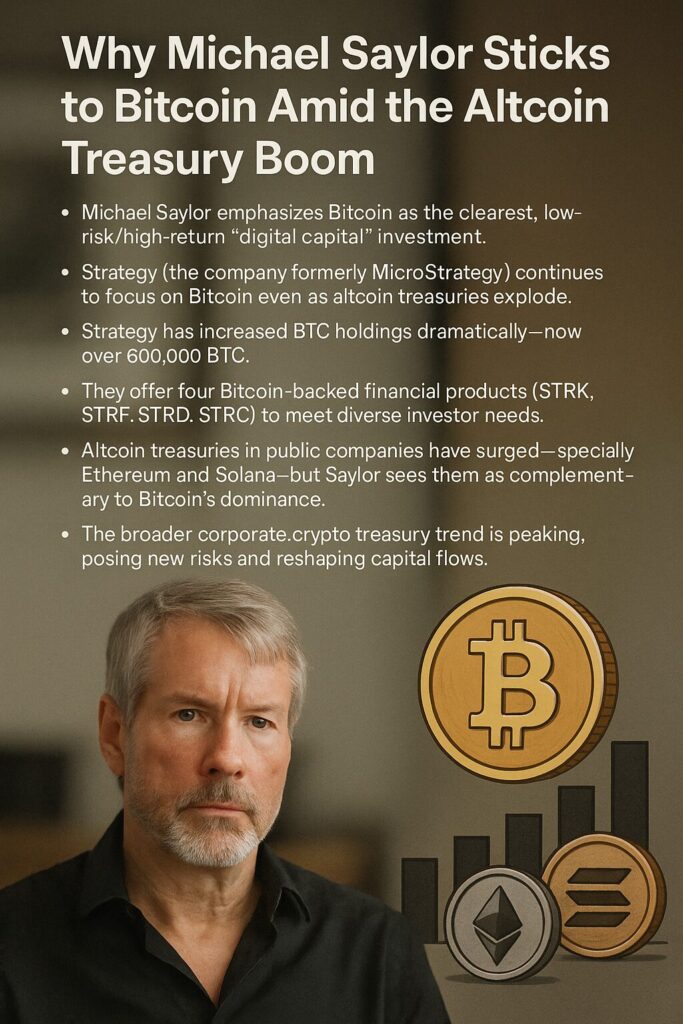
Main Points :
- Michael Saylor emphasizes Bitcoin as the clearest, low‑risk/high‑return “digital capital” investment.
- Strategy (the company formerly MicroStrategy) continues to focus on Bitcoin even as altcoin treasuries explode.
- Strategy has increased BTC holdings dramatically—now over 600,000 BTC.
- They offer four Bitcoin‑backed financial products (STRK, STRF, STRD, STRC) to meet diverse investor needs.
- Altcoin treasuries in public companies have surged—especially Ethereum and Solana—but Saylor sees them as complementary to Bitcoin’s dominance.
- The broader corporate crypto treasury trend is peaking, posing new risks and reshaping capital flows.
1. Bitcoin: The One-Straightforward Strategic Asset
Michael Saylor, Executive Chairman of Strategy, insists that Bitcoin remains the most understandable and compelling strategic investment among digital assets. He calls it “digital capital” and asserts that its performance will continue surpassing the S&P 500. Amid corporate interest in altcoins, Saylor is unshaken: Bitcoin offers the clearest pathway to low‑risk, high‑return outcomes.
2. Surging Bitcoin Reserves at Strategy
Strategy has aggressively expanded its Bitcoin holdings. In 2025, the firm raised its STRC preferred stock offering from $500 million to $2 billion, using the capital to acquire 6,220 BTC (~$739 million), bringing total holdings to approximately 607,770 BTC. This ascent places Strategy among the largest corporate Bitcoin holders globally.
3. Tailored Bitcoin-Backed Financial Instruments
To enable investors to benefit from Bitcoin’s upside while managing risk, Strategy offers several structured products:
- STRK: Offers potential upside with dividend guarantees and principal protection—ideal for risk-averse investors.
- STRF: A 21‑year senior bond backed by BTC, with ~8.5 % yield and priority in capital structure.
- STRD: A long-term, high‑yield instrument offering ~11.5 % annual return.
- STRC: A short‑term BTC‑backed preference share delivering 9 % monthly dividends—designed as an alternative to government bonds or money market funds and was the company’s largest IPO to date.
These offerings provide diversified entry points for different investor profiles while anchoring the strategy squarely in Bitcoin.
4. Altcoin Treasury Boom: Ether, Solana, XRP and Beyond
While Strategy remains focused on Bitcoin, the corporate crypto landscape is rapidly diversifying. Public companies’ altcoin treasuries ballooned from under $200 million at the start of 2025 to over $10.8 billion—a 6,700 % increase. Ethereum leads the charge, with corporate holdings soaring to ~$6.2 billion.
Companies like BitMine Immersion Technologies, Sharplink Gaming, and The Ether Machine have aggressively accumulated ETH – some crossing $100 million in holdings. Firms are also adding Solana, XRP, BNB, Dogecoin, Litecoin, and Sui to their treasuries.
However, Saylor remains cautious, calling altcoins a growing but complementary phenomenon. He reiterates that Bitcoin remains the safest, most straightforward strategic asset.
5. Corporate Crypto Treasury Craze: Growth, Risks, and Reality Check
The rush into crypto treasuries has reshaped capital markets. In 2025, 154 public companies raised nearly $100 billion to buy various crypto assets, sometimes using debt or equity. This trend has helped onboard traditional investors into crypto without direct exposure—but it may also generate systemic risk if asset values drop. Experts warn it could resemble a dot‑com bubble.
Mike Novogratz of Galaxy Digital, while optimistic about the category’s growth, says the initial boom may have peaked. Large, established treasury-focused firms still have runway, but competition and saturation may slow further acceleration.
6. What’s Next: Institutional Altcoin Strategies and Ecosystem Evolution
Ethereum, in particular, is gaining traction—corporate holdings now exceed $13 billion globally, reinforcing its narrative as a second “digital gold.” Regulations favoring stablecoins and institutional ETH products are likely fueling this shift.
Meanwhile, political actors are entering the space: U.S. federal efforts, like the Strategic Bitcoin Reserve executive order, have introduced a new layer of public-sector involvement. The “crypto summer” in public markets sees a wave of crypto-related IPOs, signaling mainstream financial integration. However, politicized ventures—such as Trump‑backed crypto treasuries—raise governance and ethical questions.
Conclusion
Michael Saylor’s enduring focus on Bitcoin, even amid an altcoin treasury boom, stems from his conviction that BTC remains the most transparent, low‑risk/high‑return form of “digital capital.” Strategy’s success in offering structured Bitcoin-backed instruments and aggressively accumulating BTC cements its leadership in the sector. While altcoins like Ethereum, Solana, and XRP are becoming institutional reserves in their own right, Saylor prefers to view them as complementary rather than rivals.
The corporate treasury landscape is diversifying at unprecedented speed—propelled by institutional demand, new financial products, and regulatory developments—but also exposing the market to new risks. Investors should approach altcoin strategies with discernment, recognizing both their upside and potential downsides. Ultimately, Bitcoin’s clarity, scale, and first-mover advantage maintain its central place in corporate crypto strategies—for now.

